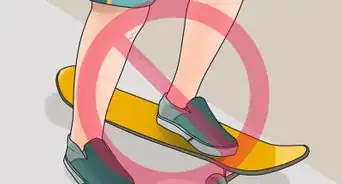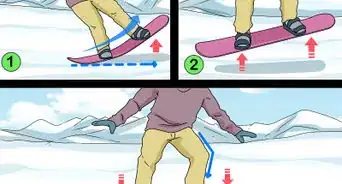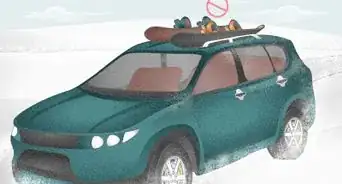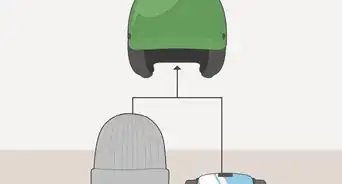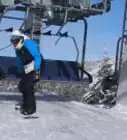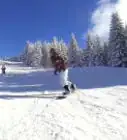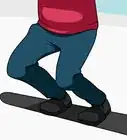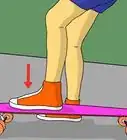This article was co-authored by Kent Bry. Kent Bry is a certified ski and snowboarding instructor and the director of Adventure Ski & Snowboard, a school based in the San Diego, California metro area. With over 50 years of skiing and snowboarding performance and instruction experience, Kent is certified by the Professional Ski Instructors of America (PSIA). Adventure Ski & Snowboard is a member of the PSIA and the American Association of Snowboard Instructors (AASI). Kent holds a BS in Recreational Therapy from San Diego State University and is also a California-registered recreational therapist.
There are 9 references cited in this article, which can be found at the bottom of the page.
This article has been viewed 1,347,310 times.
Snowboarding is a fun, thrilling sport that is enjoyed every year by thousands of people around the world. Read these steps to learn the basics of how to snowboard.
Steps
Preparing Before You Go
-
1Dress for Snowboarding. In short, you'll need clothing that keeps you warm and dry, a pair of snowboarding boots, and some safety gear.
- The full rundown of snowboarding equipment available is a long list, but these are the basics every snowboarder should have:
- A snowboard leash, to prevent runaway boards
- Snow pants or a snow bib, which is basically a pair of snow overalls
- A snow coat, not too loosely fit
- Snowboarding boots, which are specially designed to strap easily into the snowboard
- A crash helmet, to protect your head
- Thermal layers, such as long johns and wool socks
- Snow gloves with gauntlet cuffs
- Skiing or snowboarding goggles, to reduce glare and protect your eyes from particulate matter.
- The full rundown of snowboarding equipment available is a long list, but these are the basics every snowboarder should have:
-
2Check everything for fit. In particular, wear your helmet and boots properly. The helmet shouldn't move around on your head, or ride low on your eyes. It should be snug but not too tight. Boots should be tight but comfortable.
- If your boots are too big, you can end up over-tightening them and losing circulation in your feet.
- Wear snowboarding socks that come up past the top of your boots to prevent the boots (or your pants) from chafing around your ankles.[1]
Advertisement -
3Consider getting a stomp pad. This is a grip pad that goes on your snowboard, just above the binding for your back foot. It gives you a place to put your back foot temporarily, for times when you need to move a little ways but you haven't bound both of your feet to the board yet.
-
4Keep in mind there are various snowboarding styles. Most snowboards are purpose specific, but if you're more interested in one or another specific aspect of the sport, there are specialized boards that can maximize your experience in the future. It is still advised to start with a softer rocker-dominant snowboard as you will progress much faster than if you would pick a snowboard designed for high speeds.
- All-mountain boards are the standard snowboards you'll see everywhere on the mountain. They're great for speed and carving (turning) on a downhill slope, but still short and wide enough to try tricks, spins, and catching big air, as well. Boards in this category can vary vastly in terms of technical specifications such as profile, flex etc.
- Freeride snowboards are designed to float in fresh uncompressed snow (powder). These boards can be distinguished by long and wide nose, short tail and powder-specific profile. They also tend to float more on the top of the snow, which makes them easier to control.
- Freestyle or technical boards are a little bit shorter and wider than all-mountain models. They're more flexible as well, which gives them superior control for precise movements. Freestyle boards are preferred for riding snow parks (technical courses) and pipes. Boards in this category can vary wildly too. Some of them (softer and rocker-profiled ones) are also a good choice for many beginners because of their responsiveness.
- Alpine or carve boards are longer, thinner, and less flexible than the other two types. They're built for high speed and smooth carving down the side of the mountain. If a fast downhill experience is what you're after, consider an alpine board after you've learned to ride very well and carve.
-
5Check your height and weight. Even more important than the type of board you buy is the fit of the board to your body. As a general rule of thumb, your board should come up to about the height of your chin or nose when stood on end. Any lower may be too short; taller is probably too long.[2]
- Two previous sentences represent a wide-spread myth that the board should be chosen according to one's height, when in fact each board has its weight range (your height has little to do with the length of the board). For example, same person could use a 153 centimeter (60.2 in) board for learning and for jibbing (riding boxes and rails in the park), 157 centimeter (61.8 in) board for big park jumps and all-mountain use, 160 centimeter (63 in) board for freeride and 166 centimeter (65.4 in) alpine board. Always check manufacturer's recommended weight range and keep in mind conditions you will be riding in.
-
6Check the width of the board. The only really important consideration for board width is keeping your feet from sticking out too much. Be sure the board you choose is wide enough - there are special "wide" boards for those with feet bigger than US 11/EU 44.5. You should be able to tilt the board at least 55 degrees before toes or heels contact the surface, but then again it depends on how aggressively will you be tilting the board while riding. If your toes and heels don't stick out at all - you will not have so much control over the board.
-
7Review other considerations. As a beginning boarder, price is probably a big concern for you. There are definite differences in performance between a top-of-the-line board and something basic, but almost always it is easier to learn with an appropriate "beginner" board than top-of-the-line one since expensive boards are often designed for certain "non-beginner" purposes.
- To save extra money, consider buying a lightly-used snowboard at a swap, or buying a previous year's model of the board you want. These are basically just as good as their current equivalents and can often be had for a much lower price.
- Consider what graphics, if any, you want on the underside of your board. If it's something you care about, choosing the right design can help you make a fun personal statement on the slopes.
-
8Determine your lead foot. You should know which foot you'll be leading with before you head up to the slopes. This will help you know how to set the bindings when you snowboard. An easy way to check your lead foot is to run and slide across a very smooth floor, such as polished concrete or hardwood. Whichever foot ends up sticking out in front of you is your lead foot. Another way to find your lead foot is to stand with your feet squared and have a friend push you from behind. The foot you step forward with first should be your lead foot. It's just a natural reaction. [3]
- Don't guess. Your lead foot won't necessarily match up with the side of your body you prefer for anything else. Being right- or left-handed, or sliding into base with a particular foot in baseball, doesn't necessarily mean your lead foot will follow suit.
- Don't worry. If you find that you prefer not to lead with your lead foot, nothing's stopping you from doing so. Finding your lead foot is just a useful way for most people to figure out which way to stand on the board. It's not set in stone.
-
9Determine what type of bindings you have. There are two common types, strap bindings and speed entry bindings.
- Strap bindings are the most commonly seen snowboard bindings. They consist of a base for the bottom of your boot, and a set of secure synthetic straps (usually two straps) that are tightened over the boot to lock it into the base.
- Speed entry (or convenience entry) bindings look similar to strap bindings, except the back of the boot base (called the “highback”) has a hinge that allows you to slide your foot in quickly. Speed entry bindings are common, but tend to be a bit more expensive than strap bindings.
- There are other, rarer types of bindings available, but these are not often seen except on high-end boards, particular brands and really old bindings.
-
10Fit your bindings. Put your lead foot in the front binding. Fasten your bindings tightly and be sure the base of the binding fits your boot snugly, then repeat for your other foot. Move and bounce around a bit to get a feel for the board.
- If the board seems to be on backwards when you look down at it, you may need to have the bindings turned to match your stance. If you're buying a new board, the shop will probably be happy to do this for you for free.
- If you feel unstable, your bindings may be too close together or too far apart. Check to be sure your feet are roughly shoulder-width apart to ensure a proper stance.
- Check the angles of bindings. The angle between both bindings should be 24 to 30 degrees. There are two main types of stance - "duck" or "symmetrical" (for example 15 and -15) or "forward" (for example 24 and -6). While mostly a thing of personal preference, angles of your choice should represent how you will be riding. Symmetrical stance for park riding, slightly forward stance for higher speeds. Alpine boards need a lot more forward stance.
Learning the Basics
-
1Get on your snowboard. Secure your lead foot in place, but leave your back foot free for now. Once your lead foot is securely bound to your board, put on your snowboard leash to keep your snowboard from escaping down a hill when you step out of it. Leashes come in varying lengths; the most common type is long enough to strap below your knee. Although the leash should be among least of your concerns - before even considering using a lift a series of exercises with one foot strapped in should be done.
- Secure the leash to your snowboard, if it's not already integrated into the binding.[4]
- Wrap the leash around your lower leg and secure it snugly. For short wire leashes, attach the other end to your boot lace instead.
- Be sure your leash is clearly visible. Many resorts won't allow you to snowboard without a visible leash.[5]
-
2Ride the ski lift up once ready. Push off the snow with your back foot to slide forward on the board like a skateboard, and let the lift chair sync up with you to get on it smoothly.[6]
- Your snowboard will dangle a bit from your lead foot as you ride up. This is fine.
-
3Get off the ski lift. Once you reach the top of the lift, slide off the chair on your board. To avoid falling off, align the board with movement direction and as soon as it touches the snow - shift at least 50% of your body weight onto front foot. Press the back foot against back binding and keep your back straight. You'll be on a little hill where you can then turn and make your way to the larger hill. Ride down to the flat area.[7]
- If you equipped your board with a stomp pad, it should be easy for you to stay balanced for this part.
-
4Strap up. Go to the edge of the hill and sit down with your board perpendicular to the slope. This makes your board act as “brake” to keep you from sliding.
- Put your rear boot into its binding. Make sure the bindings are snug and secure.
- If you can move your foot while in the binding, or pull your heel up from the base, it's too loose.
- Double check your lead foot and leash, and ensure they're secure as well.
- Put your rear boot into its binding. Make sure the bindings are snug and secure.
-
5Head downhill. Now that you're strapped in, you're ready to ride. Stand up and don't turn your snowboard so that the lead end of the board is pointing down the hill. Learn to slip down the fall line sideways first, or you'll simply go downhill with full speed. Once you can control the speed and stop - sit down, roll over and learn to control the speed and stop on the front edge.
- To move to the side, shift some of your body weight to one of your feet, use that foot as a pedal to turn more or less downhill. Learn to control your movement direction while keeping most of your weight on that foot.
- Keep your knees slightly bent and your back straight to maintain balance as you gather speed.
-
6Practice garlands. It's important to know how to control your speed, and turning is the only way to do this while you're on the slope. Garland is a turn without the edge change. When you can do garlands on both front and back edges - you might ask someone to assist you when trying your first full turn with an edge change. If you will proceed to full turns with an edge change without practicing garlands, you might end up with an incorrect technique ("sweeping with back foot") as displayed in the image above. That will stop you from progressing in the future, and fixing incorrect technique might take up to 10 times longer than learning from scratch.
- Lean your body into the side of the slope to put weight on one edge of your snowboard. The edge your feet are pointing towards is the “toe edge;” the edge behind them is the “heel edge.”
- Try both heel and toe edge garlands. You have to be able to do both with a very similar radius. Make sure to control your garland with weight shift (and fine tune with your front foot, using it as "pedal"). It is a good idea to have most of your body weight on a front foot (lean forward) when the board is headed down the fall line. The biggest mistake of all beginners is keeping body weight on back foot. In such case leaning onto heel/toe edge does not make the board turn properly, as if your weight was on both feet. Trying to keep most of your weight on a front foot while heading down the fall line will ensure that your weight is not on your back foot, and after some time it will feel very natural to keep your weight on both feet at all times.
- Use weight shift to control your garlands and turns. While some schools teach to help yourself with shoulder rotation, this method might cover your mistakes, but not fix them. Maintain a straight back and bent knees as you do this, for safety reasons.
-
7Come to a stop. Come to a near-stop, if you prefer; the important thing is to know how to do it. Being able to stop and restart is key to staying safe on the slopes.[8]
- Turn your snowboard so that you're perpendicular to the slope of the mountain. Be sure nobody is bearing down on your position from further up the hill.
- Lean back into the slope of the hill as far as you can without falling over. This will put almost your entire weight on one edge of the board, forcing it to slow quickly.
- As you lean into the hill, lean back on your rear foot at the same time. This further reduces the effective surface area of the board. The more you lean back, the faster you'll stop.
- Don't lean onto back foot when doing a turn and trying to stop - you will be developing wrong habits. Ideally your weight should always be on both feet, however for learning purposes it is good to have most of your body weight on your front foot during certain phases of a turn.
- Once you're ready to continue, shift your weight diagonally so the board starts turning downward. Apply pressure to your lead foot again.
- Read 10 FIS rules; they apply in all ski resorts.
Techniques, Exercises, and Gear
Community Q&A
-
QuestionHow do I go faster without falling down?
 Community AnswerLower your center of gravity (i.e. bend your knees) and lean forward. Standing up straight and leaning back will make you lose your balance. Bending forward and placing pressure on your leading foot will make you go faster.
Community AnswerLower your center of gravity (i.e. bend your knees) and lean forward. Standing up straight and leaning back will make you lose your balance. Bending forward and placing pressure on your leading foot will make you go faster. -
QuestionHow do you know when to stop?
 Community AnswerYou'll know to stop when your legs start to hurt or you start messing up a bit (it means you're not concentrating).
Community AnswerYou'll know to stop when your legs start to hurt or you start messing up a bit (it means you're not concentrating). -
QuestionWhy should I sit down at the top of the mountain?
 Community AnswerYou do this so that you won't slide around when you are trying to attach your non-leading foot to the board.
Community AnswerYou do this so that you won't slide around when you are trying to attach your non-leading foot to the board.
Warnings
- If anything seems amiss anywhere on the mountain, alert the proper authorities as soon as you can reach them.⧼thumbs_response⧽
- Always bring a friend or partner when you snowboard. If you can't do so, let someone responsible know your schedule, at least, so that they'll know if something has happened to you.⧼thumbs_response⧽
- Don't fall onto your hands if you can possibly help it, as you're likely to hurt your wrists. The more surface area your body hits the ground with, the more the impact will be distributed, and the less damage you'll take. Use your whole arms at the very least; if you can let your body roll on impact, do so.[9]⧼thumbs_response⧽
References
- ↑ https://counselors.calvinistcadets.org/wp-content/uploads/2013/07/snowboardskiingCouns.pdf
- ↑ https://www.snowledge.co/blog/what-size-snowboard-do-i-need-snowboard-sizing-explained/
- ↑ http://www.elemenja.com/words/ttp_begin_snowboard_1.htm
- ↑ https://www.youtube.com/watch?v=_u2Gp3yUc9s&feature=emb_logo
- ↑ https://www.youtube.com/watch?v=_u2Gp3yUc9s&feature=emb_logo
- ↑ http://www.mechanicsofsport.com/skiing/learning_to_ski/chair_lifts.html
- ↑ http://www.mechanicsofsport.com/skiing/learning_to_ski/chair_lifts.html
- ↑ https://www.youtube.com/watch?v=qlyin7vUn00&feature=emb_logo
- ↑ https://www.worldwideinsure.com/travel-blog/2017/01/common-snowboarding-injuries-avoid/
About This Article
To go snowboarding, strap both boots to the board and make sure the leash is attached to the board and your bindings. Then head down the hill, keeping your back straight and your knees slightly bent to keep your balance. To turn, shift your weight to one foot and use that foot to steer the board. If you need to stop, turn your board so that it is perpendicular to the slope and lean back. If you want to learn how to get the right gear and board before getting on the slopes, keep reading!
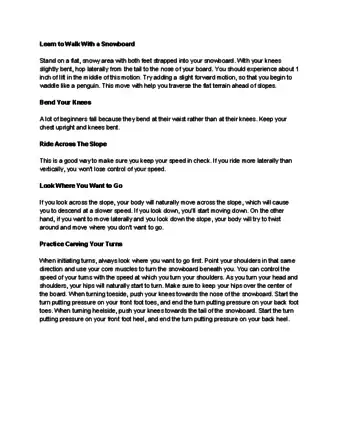
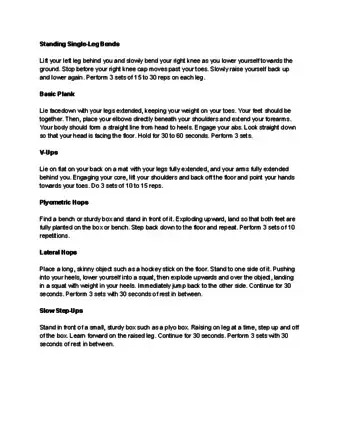
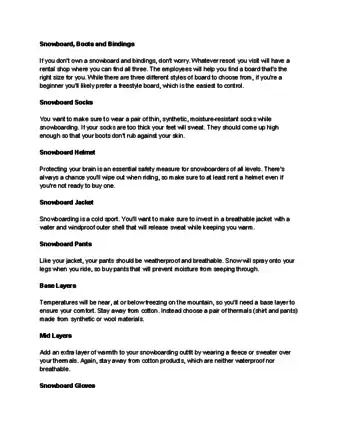
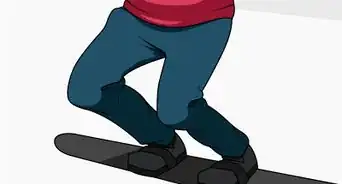
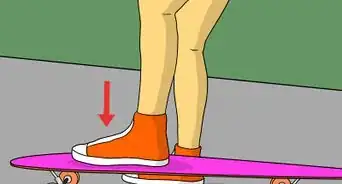
-Step-9.webp)
